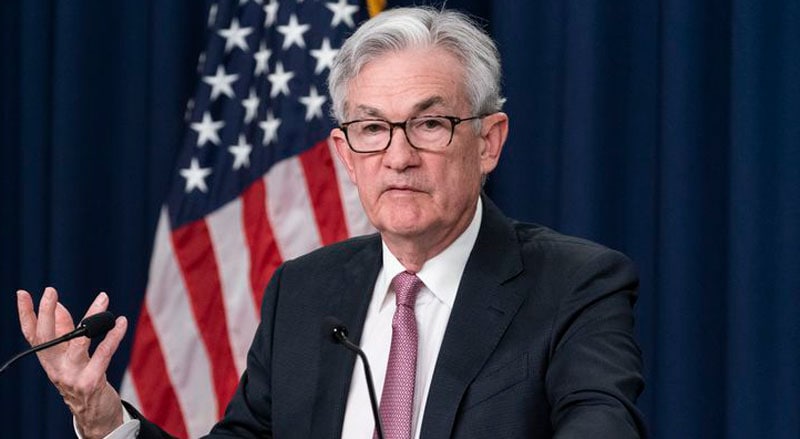Federal Reserve Chair Jerome Powell has laid out a grim gameplan as he vows to crush demand and hurt the job market in an effort to tame inflation.
Powell sent a stark message to markets following the decision to hike rates by another 75 basis points.
The U.S. central bank chief warned reporters that there is no “painless” way to bring down inflation.
The Fed chair also revealed that there could be more than just a “relatively modest” rise in unemployment as the Federal Reserve tightens aggressively to dent demand.
Powell made the remarks during a press conference on Wednesday.
His comments came after a decision by the Federal Open Market Committee (FOMC) to deliver another jumbo rate hike, bringing the benchmark lending rate to a range between 3.00–3.25 percent.
The central bank head said that inflation was “running too high” and warned that rates are heading higher and poised to stay at a restrictive level for “some time.”
“The historical record cautions strongly against prematurely loosening policy,” Powell told reporters.
He added that FOMC members see the Fed Funds rate peaking at 4.6 percent by the end of 2023 before declining to 2.9 percent by the end of 2025.
Powell said at the press conference that the Fed is taking “forceful and rapid steps” to bring down demand in the U.S. economy, which has been the dominant factor behind soaring inflation.
While there’s been debate around whether supply-side bottlenecks or high consumer demand caused the inflationary tidal wave inundating American households, a recent Fed study concluded that around 60 percent of the cause can be attributed to a stimulus-fueled demand surge.
Powell vowed to erode demand to bring it into balance with supply, which has been constrained by various factors, including geopolitical conflicts and the rejigging of supply chains as de-globalization grinds ahead.
The Fed chief also noted that bringing inflation down to the central bank’s 2 percent target would likely require a “sustained period of below-trend growth” and that there would “very likely be some softening of labor market conditions.”
He added that a soft landing will be “very challenging” and that failing to quell inflation and restore price stability is not an option as that would mean “far greater pain later on.”
Powell was blunt about the “pain” to come.
He cited rising joblessness and singling out the housing market—which has been a major contributor to inflation—as being likely in need of a “correction.”
As the Fed embarked on its rate-tightening cycle, the housing market has shown growing signs of cooling.
The National Association of Realtors (NAR) reported on Sept. 21 that sales of previously owned homes dropped for the seventh straight month.
“The housing sector is the most sensitive to and experiences the most immediate impacts from the Federal Reserve’s interest rate policy changes,” NAR Chief Economist Lawrence Yun said in a statement.
“The softness in home sales reflects this year’s escalating mortgage rates.”
Mortgage applications have ticked up week-over-week for the first time in six weeks, according to the Mortgage Bankers Association (MBA), but remain far below 2021 levels.
“As with the swings in rates and other uncertainties around the housing market and broader economy, mortgage applications increased for the first time in six weeks but remained well below last year’s levels, with purchase applications 30 percent lower and refinance activity down 83 percent,” Joel Kan, MBA’s Associate Vice President of Economic and Industry Forecasting, said in a statement.
The 30-year fixed mortgage rose to 6.25 percent last week, according to the MBA, which is the highest level since 2008.
Homebuilder optimism has dropped sharply, with Gregory Daco, chief economist at Ernst & Young, saying in a statement that the survey “points to a housing recession in September.”
The Zillow Home Value Index has recorded its second consecutive monthly drop, with nearly a quarter of homes for sale experiencing a price drop in August, the highest since 2012.
Besides evidence of a slowdown in the housing market, other economic indicators have been flashing warning signs.
Industrial production lost momentum in August, falling by 0.2 percent.
On Tuesday, The Atlanta Fed lowered its gross domestic product (GDP) estimate for the third quarter to 0.3 percent in what appears to be a falling trend.
Just five days earlier, the Atlanta Fed’s projections called for 0.5 percent growth in the third quarter, and a month prior, it was estimating that GDP would expand by over 2 percent.
Consumer sentiment, as measured by the University of Michigan’s Consumer Sentiment Index, has edged up a little but remains near historic lows.
Economist Nouriel Roubini, who’s been dubbed “Dr. Doom” for his pessimistic-yet-accurate prediction of a financial market meltdown in 2007–2008, recently predicted a “long and ugly” recession in the United States that will send risk assets plunging.
“Even in a plain vanilla recession, the S&P 500 can fall by 30 percent,” Roubini told Bloomberg in a recent interview.
But he expects “a real hard landing,” which could send the benchmark equities index down 40 percent.
He said it’s “mission impossible” for the Fed to hit a soft landing as it tightens policy to bring inflation down to 2 percent.
Roubini sees a combination of economic stagnation and persistently high inflation, much like the dreaded stagflationary spell in the 1970s that bedeviled economies.

Our comment section is restricted to members of the Slay News community only.
To join, create a free account HERE.
If you are already a member, log in HERE.